The final issue of the Wavelength ‘zine is printed in February 2005, as Wavelength celebrates its fifth birthday, though our inimitable band interviews are still published online. The Toronto music community gathers on the Internet message board Stillepost, and show promotion moves over to nascent social media platforms. In the wake of international indie breakouts, the local music scene grows in strength and diversity, with acts like Cadence Weapon, METZ, Maylee Todd and the Weather Station taking the WL stage. Wavelength begins presenting more special events in alternative spaces outside of Sunday nights at Sneaky Dee’s, and makes steps towards professionalizing, including incorporating as a non-profit. In 2009, an Eye Weekly cover story announces that the upcoming 10th anniversary will mark the end of the weekly series — though it will continue as a monthly in the new decade. That fall, after seven years at Sneak’s, Wavelength finds a new home when the Garrison opens its doors on Dundas West.
The Internet Era (2005-2009)
The Internet Era (2005-2009)
The final issue of the Wavelength ‘zine is printed in February 2005, as Wavelength celebrates its fifth birthday, though our inimitable band interviews are still published online. The Toronto music community gathers on the Internet message board Stillepost, and show promotion moves over to nascent social media platforms. In the wake of international indie breakouts, the local music scene grows in strength and diversity, with acts like Cadence Weapon, METZ, Maylee Todd and the Weather Station taking the WL stage. Wavelength begins presenting more special events in alternative spaces outside of Sunday nights at Sneaky Dee’s, and makes steps towards professionalizing, including incorporating as a non-profit. In 2009, an Eye Weekly cover story announces that the upcoming 10th anniversary will mark the end of the weekly series — though it will continue as a monthly in the new decade. That fall, after seven years at Sneak’s, Wavelength finds a new home when the Garrison opens its doors on Dundas West.
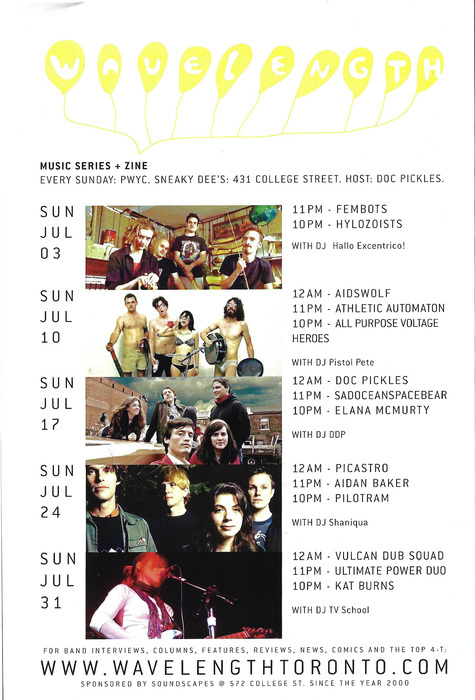
It’s the end of an era: the ‘zine ceases publication on WL’s fifth anniversary due to financial challenges, volunteer burnout, and the relentless rise of social media, though the inimitable WL band interview continues to be published online. Live shows are as packed as ever. Memorable performances include Jens Lekman with a nasty cold, and two sets by a teenage Edmonton rapper called Cadence Weapon, the first after the last-minute cancellation of Ear to the Ground fest at Exhibition Place, and the second alongside Spiral Beach, a band of Toronto high schoolers featuring future members of Moon King, Doldrums, Rapport, Austra, and Crasher.
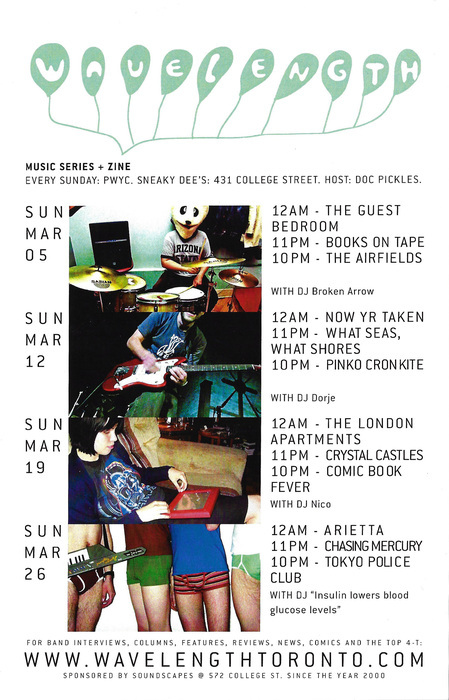
Wavelength takes some tentative steps towards professionalizing, including applying for — anWavelength takes some tentative steps towards professionalizing, including applying for — and receiving — its first Toronto Arts Council grant and hosting its first indie-music panel discussion. The organization also begins to step more outside the confines of Sundays at Sneaky Dee’s, kicking off co-presenting partnerships with Harbourfront Centre, the Images Festival, Mercer Union, and the Music Gallery’s new X Avant Festival. Memorable performances include Crystal Castles and Tokyo Police Club on consecutive weeks right before they both blew up, NYC avant-rock sensations Dirty Projectors, and a new project by a trio of regular WL attendees called the Rural Alberta Advantage. d receiving — its first Toronto Arts Council grant and hosting its first indie-music panel discussion. The organization also begins to step more outside the confines of Sundays at Sneaky Dee's, kicking off co-presenting partnerships with Harbourfront Centre, the Images Festival, Mercer Union, and the Music Gallery’s new X Avant Festival. Memorable performances include Crystal Castles and Tokyo Police Club on consecutive weeks right before they both blew up, NYC avant-rock sensations Dirty Projectors, and a new project by a trio of regular WL attendees called the Rural Alberta Advantage.
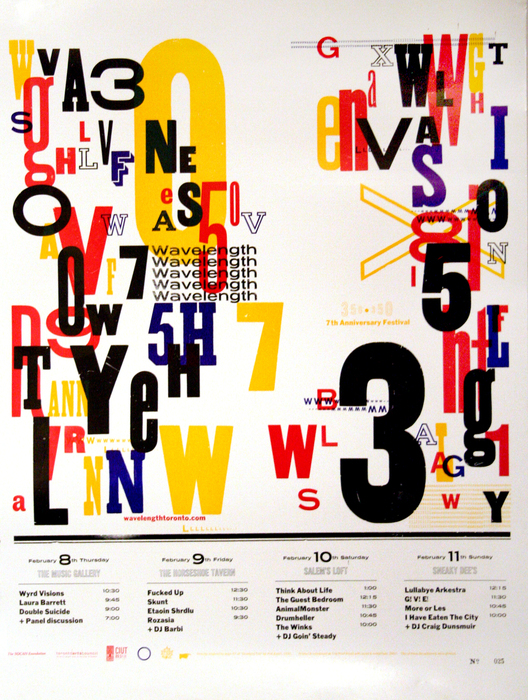
Wavelength 350 (Feb. 8–11), our seventh anniversary, kicks off with a challenging panel discussion, “Diversity: Our Strength?,” tackling the lack of cultural diversity within Toronto’s independent music scene. Wavelength makes another big step towards professionalizing, incorporating as a non-profit. Memorable performances include a double-header of indie-folk collective Bruce Peninsula and Eritrean krar player Daniel Nebiat (a direct curatorial outcome of the diversity panel), the first appearance of audiovisual electro-popster Rich Aucoin, and Montreal trio Sister Suvi including a pre-Tune-Yards Merrill Garbus.
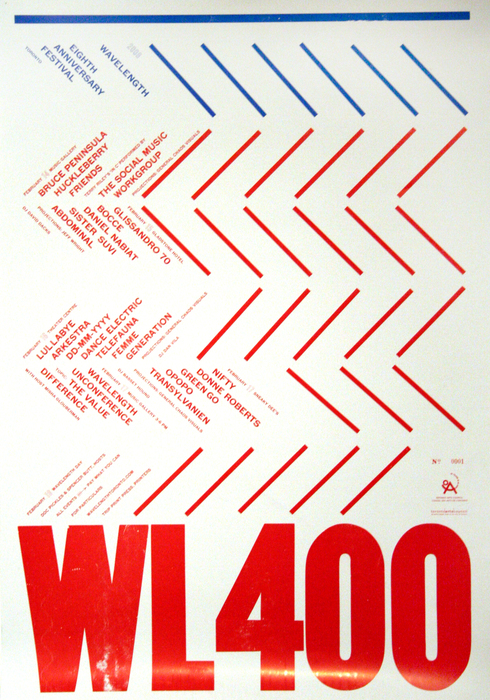
Wavelength continues to produce and present quarterly Special Events outside its weekly series, including the Kalimba Summit, centring on the titular southern African thumb piano. Midway through the year, the WL programmers make a big decision: with Sunday turnout gradually declining and more of the WL “vibe” found at the Special Events, the weekly Sunday night series will end 18 months later, on its 10th anniversary, and continue on as a monthly. Memorable performances include a sold-out benefit for the Music Gallery featuring Jens Lekman, Final Fantasy, and Katie Stelmanis (later of Austra), and an early Tune-Yards show before Merrill Garbus relocates to Oakland.
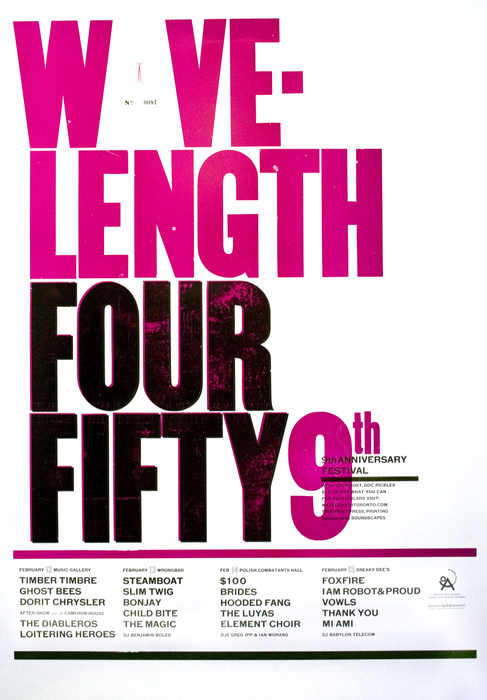
A cover story in Eye Weekly that announces the end of Wavelength’s weekly series a year ahead of time yields cries of “say it ain’t so” from the community, but fears are eschewed after the ninth-anniversary fest Wavelength 450 continues the exploration of new spaces and new faves, with packed houses all weekend, coinciding with a brand-new Ontario public holiday, Family Day. That fall, Wavelength relocates the weekly series one last time after seven years at Sneaky Dee’s, to a new club in Little Portugal called the Garrison. Memorable shows include Japandroids, METZ, Fugazi bassist Joe Lally, Sook-Yin Lee, and the Strumbellas years before hitting alt-country platinum with “Spirits.”
